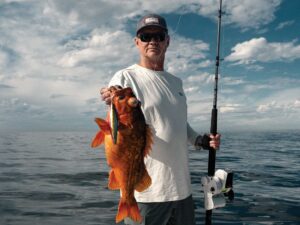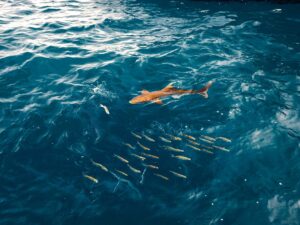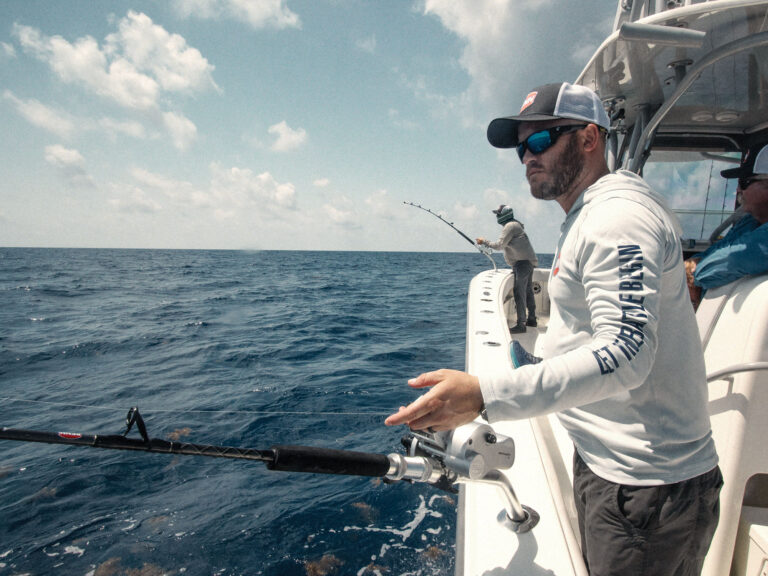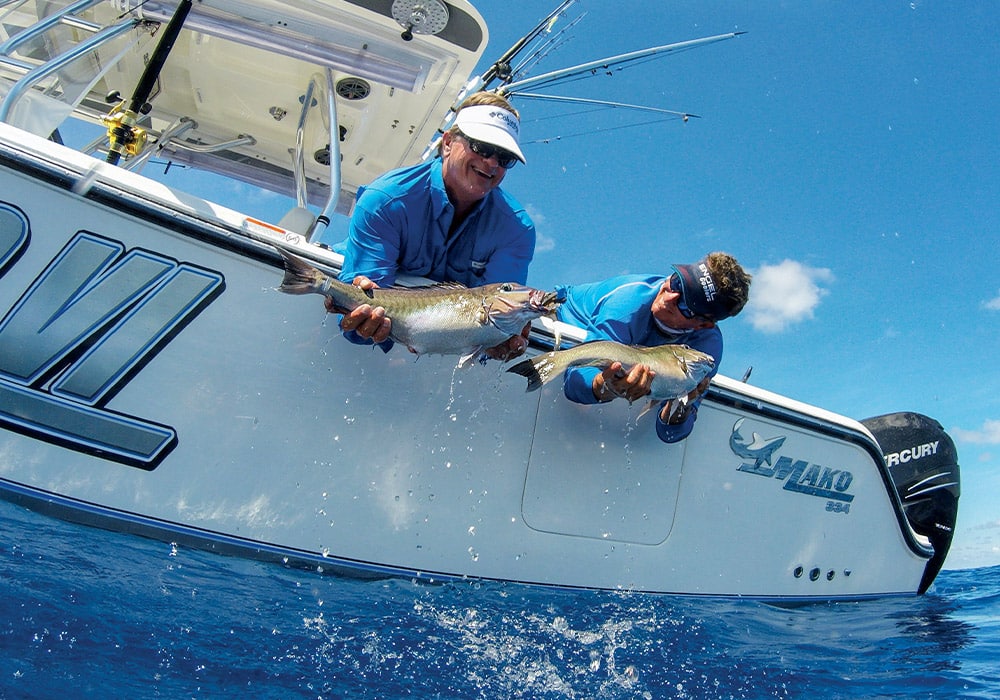
My arms were sore, my back in knots, and my head was spinning. I had hooked into tilefish five drops in a row, and my latest pain and suffering were inflicted by a pair of writhing blueline tilefish on my line, doing the tango 250 feet below the boat. As much as I complained about the torture, I was loving every minute of the deepwater action, and I wasn’t about to let up.
Tile Floor
About 10 years ago, anglers from South Jersey to North Carolina discovered acres of blueline tilefish covering the bottom at the edge of the continental shelf. Since then, increased regulations and shifting populations have made fishing more challenging, but if you don’t mind doing some work, the action can still be excellent.
In the last decade, tilefish numbers have peaked and declined along with the number of anglers targeting the fish. Tilefish are slow-growing, living over 40 years, so once an area has been depleted, anglers have to find new hunting grounds. Heavy pressure on popular tilefishing grounds put a dent in the population; however, the species’ range is so expansive—covering thousands of square miles—that anglers who look for the fish usually find them.
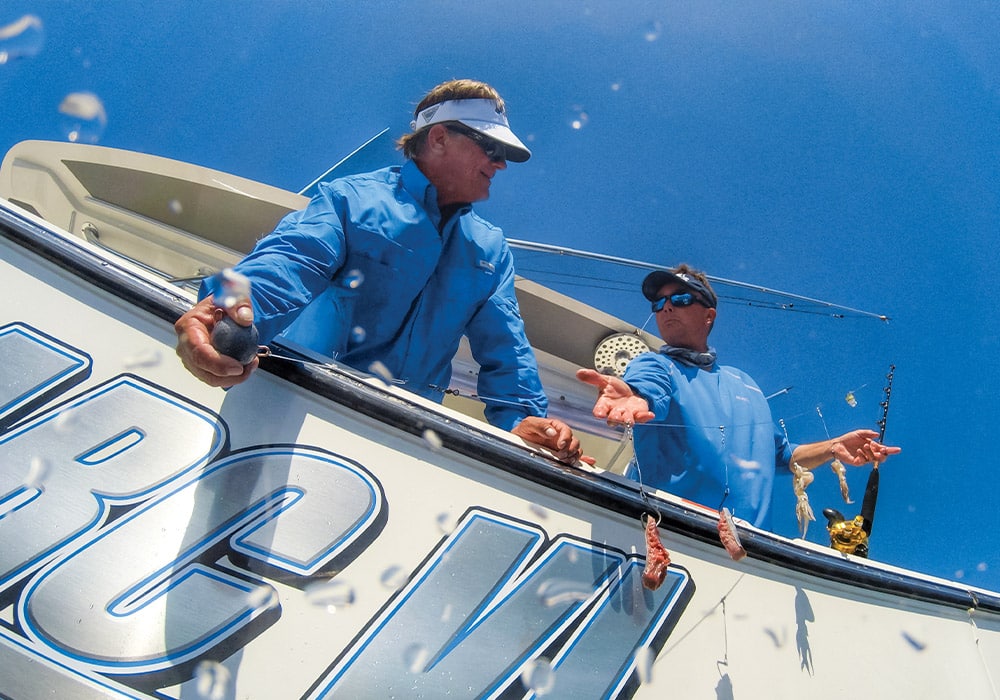
Bottom Hunting
Blueline tilefish range from Massachusetts to the Gulf of Mexico, but the heart of the population gathers off the mid-Atlantic coast. Bluelines have been caught in water as shallow as 25 fathoms, but the best action takes place in depths of 50 to 100 fathoms.
For years, I’ve been tilefishing aboard Good Times with captains Andy Piland and Tim Hagerich, who spend most of the summer looking for tilefish off Hatteras, North Carolina. “People think we have secret locations,” Hagerich says. The truth is the pair rarely fish the same place twice.
While Hagerich spends many hours trolling for surface-feeding pelagics, he’s always looking for scratches on the bottom, using his fish finder to locate tilefish. He turns up the gain and sets the display to split screen. That way, not only does he spot fish, but he also detects soft sand or mud where tilefish burrow to avoid predators. “One side is zoomed in on the bottom,” he explains, “and if we see any speck on the screen, we stop and make a drop.”
He most often finds bluelines on flat bottom, especially along the top edge of a drop-off. Unlike grouper and golden tilefish, bluelines don’t favor the rocky face of an underwater cliff. Instead, they show predilection for open areas. “There are places where we can drift for 10 miles and catch tilefish,” Hagerich says.
When drifting for tilefish, boat handling is essential, Hagerich insists, “so a skilled captain greatly contributes to the angler’s success.” Offshore currents can make tilefishing difficult, especially off Hatteras, where the water moves as fast as 4 knots. For proper bait presentation, Hagerich heads into the current slowly, bumping the boat ahead just fast enough to keep the lines vertical, which helps avoid tangles and is also the best way to get bites. Hagerich says tilefish want their meal on the bottom. “They won’t chase a bait. The rig must be right on the bottom to get a bite,” he explains.
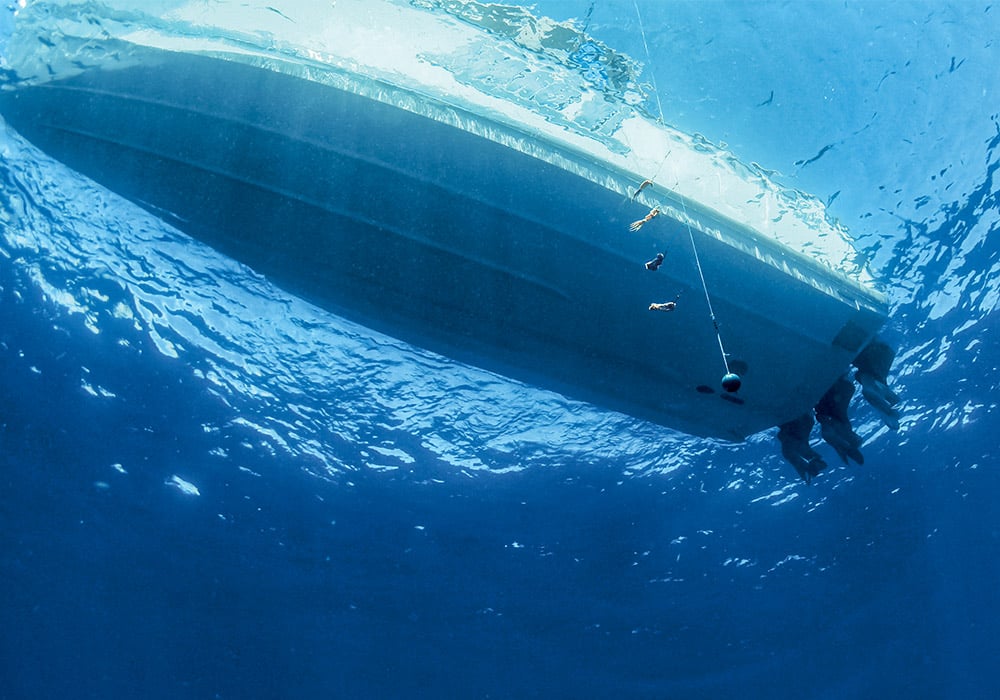
Drop Time
To fire up the fish, Hagerich makes several drifts over a mark. “If we catch a couple, I make another drift through the same area. It can take a couple of drifts to get the fish biting, so we often get twice as many bites on the second drift,” he says.
“Bouncing the sinker on the bottom seems to turn on the bite,” claims Hagerich, who believes the fish are drawn by the vibrations. “It can’t be easy to hunt in the dark,” so appealing to the tilefish’s sense of movement and sound lures them out of hiding. Since the fish prefer soft sand and mud bottom, there’s little chance to get snagged. Drop the sinker all the way down and bounce it as the boat drifts. If the line angles out and the sinker looses contact with the ocean floor, reel in and drop again.
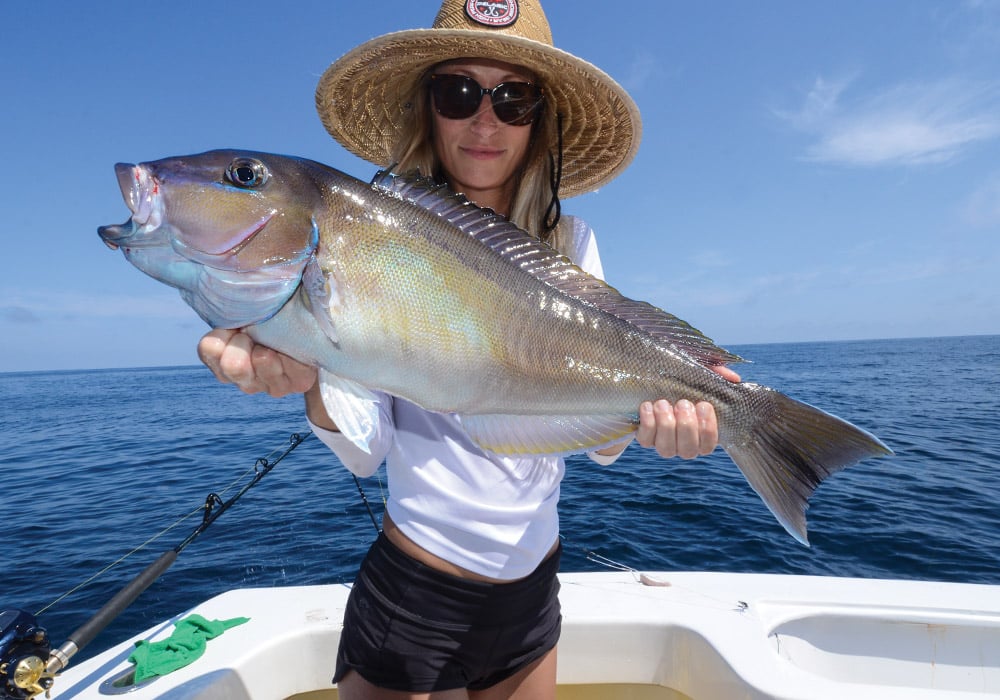
Weapons of Choice
Reeling up a pound of lead and two mad tilefish 200 feet or more involves heavy lifting and hard cranking. Therefore, think lightweight and sensitive when selecting a rod for the job. I chose a 7-foot medium-heavy Shimano Tallus rod. It has the length to reach over the side of the boat and is stiff enough to work the weight.
Weight is also important when picking a reel, and so is a lever drag. A high-speed reel is great for ripping vertical jigs, but not so much fun for bottom bouncing. The 4-to-1 retrieve ratio on my Accurate Boss 400 is fast enough to make quick work of retrieving the bait and has sufficient torque to horse a stubborn tilefish off the bottom. The lever drag on the Accurate allows me to adjust the pressure as a big fish gets closer to the surface.
The reel holds 325 yards of 50-pound braided line, and it’s smart to choose an eight-strand braid like PowerPro Super 8 Slick, which affords great strength and sensitivity, plus a thin diameter that drops through the water with the least resistance. I like a high-vis line to make it easy for the captain to monitor the angle of my line and adjust the boat’s drift.
I attach a 250-pound-test swivel to the main line, then the tilefish rig, which starts with two arm lengths of 100-pound mono with a surgeon’s loop on the end for a 16- to 36-ounce sinker. I add two 8-inch dropper loops along the length of mono, spacing them far enough apart to keep one hook from snagging the other, and I go with 8/0 Owner Mutu offset circle hooks so the fish hook themselves. To spice up the rig, I add a 4-inch glow-in-the-dark rubber squid or a red bucktail skirt to the loop ahead of each hook.
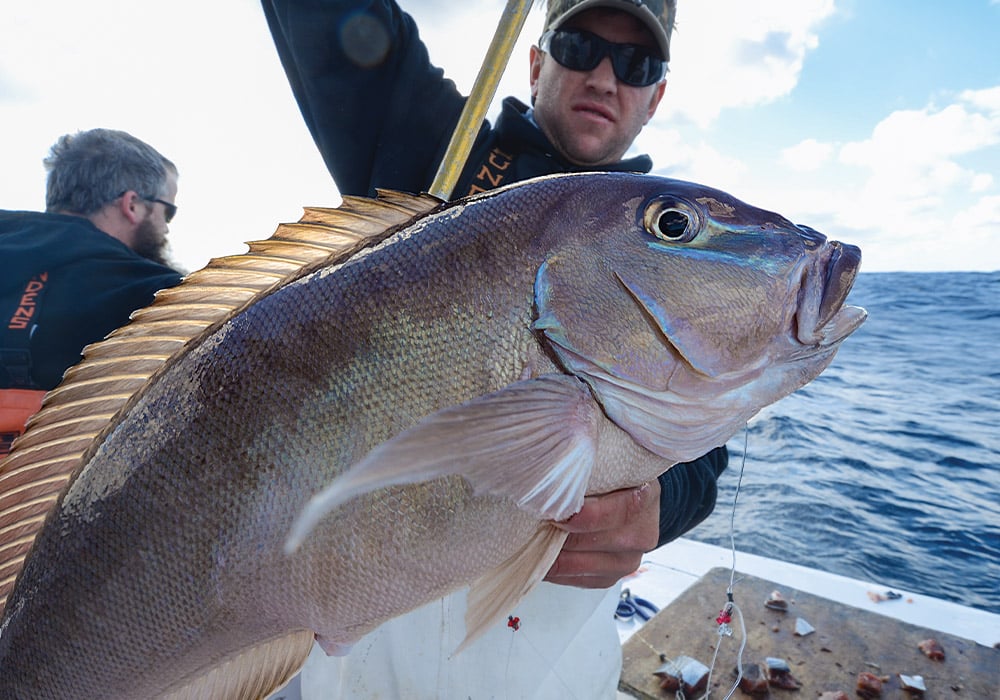
Baits or Lures
Cut albacore or squid make the best bait. A small 1-by-2-inch chunk is enough to entice the tilefish without the meat gobbing up and affecting the hook’s performance.
If I find my bait getting robbed by smaller fish—tilefish often live alongside black seabass—I swap the bottom rig to a 4- to 8-ounce Butterfly jig or 3- to 6-ounce Lucanus. I add 6 feet of 80-pound fluorocarbon leader between the jig and my main line with a Bimini to no-name knot connection. When the fishing is hot, jigs speed up the action. I don’t have to stop to bait the hooks again and again, and I often get several bites on one drop. There’s nothing worse than dropping my rig to the bottom 250 feet below only to miss a bite and wonder if I have any bait left.
Read Next: Quick-Change Deep-Drop Rig for Tilefish
On my last tilefish trip, we made a half-dozen stops before finding the fish. Dropping, drifting and running, we explored new territory until we got a bite, then the action was nonstop with every drop resulting in a heavy bite and a battle with a stubborn tilefish. By the time we had a limit, I was worn out. Total exhaustion never felt so good.
SWS Planner
What: Blueline tilefish
When: Continental shelf from North Carolina to New Jersey
Where: Year-round; check regional seasons and size limits
Who: The following captains excel at tilefishing in mid-Atlantic waters:
Hatteras, North Carolina
Captains Andy Piland and Tim Hagerich
goodtimessportfishing.com
757-216-9273
Virginia Beach, Virginia
Capt. Randy Butler
rebelsportfishing.com
757-932-0036
SWS Tackle Box
Rod: 7-foot medium-heavy conventional with stiff tip, such as Shimano Tallus
Reel: 20-class conventional, such as Accurate Boss 400
Line: 50-pound braided line, 100-pound fluorocarbon
Terminal Tackle: 250-pound swivel, 8/0 Owner circle hooks, 16- to 32-ounce bank sinker
Lures: 3- to 6-ounce Lucanus jig, 4- to 8-ounce Shimano Butterfly jig

